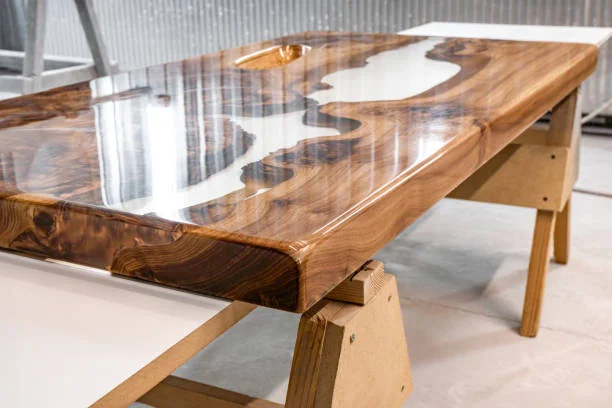You want to get an epoxy resin table, huh? Good decision! These tables really stand out. Not only do they have a shiny polish and bright hues, but each one has its own rhythm and a miniature universe frozen between slabs o
But before you place an order or fall in love with a photo, It’s made of both natural and synthetic materials, and the way they come together is what makes the difference.
ThunderWood Studio shows off the different styles and personalities that these sculptures can have, whether you’re looking for inspiration or just want to get a sense of the craft.
There’s so much more to discover—browse our related posts!
Epoxy Resin Isn’t Magic—But It’s Pretty Close
There are two parts to epoxy: a resin and a hardener. When you combine it, it flows like thick syrup and then hardens into a surface that looks like glass. When you pour it between pieces of wood, it gives the river the impression that people love so much.
You can color it, tint it, or leave it plain. Some people put little things or metallic particles into the mix. It looks nice, but it’s not unbreakable. You shouldn’t put hot pots or things with rough bottoms straight on the surface. Scratches can happen over time, especially on finishes that are very shiny.
If you take care of it, though, a well-made resin table can last for years and get more interesting as time goes on.
Not All Wood Is the Same
The resin is the headliner, while the wood sets the ambiance. Walnut is dark and rich, maple is lighter and cleaner, while oak has that classic, slightly rough look.
How the wood has been handled is more important than what kind it is. To make a nice table, you need dry, stable slabs. These are usually ones that have been carefully air-dried or kiln-dried for months. This stops things from warping, cracking, or doing other things that are unexpected later.
And then there’s the edge. Some tables let the wood’s natural living edge show, which means the table is shaped by the curves and irregularities. Some folks prefer a clean, straight cut. The first one is more down-to-earth, whereas the second one is more modern. You can choose what fits your space; neither is right or wrong.
Form Follows Function
Before getting carried away by colors or finishes, think about where the table will live and what you’ll use it for.
- Dining room? You’ll want something sturdy, easy to clean, and resistant to daily wear.
- Desk? Having a smooth surface is important, especially if you are writing or using a mouse.
- Accent table? That’s your chance to play—with pigment, unusual shapes, or bold contrast.
Also consider things like table height, legroom, and whether the base design will interfere with chairs. A beautiful top can only go so far if the table doesn’t work for your daily needs.
Resin Colors Don’t Always Look the Same in Person
A lot of first-time buyers don’t expect this. A smoky black resin in a studio shot might read blue-gray in a sunlit room. A deep ocean tint could look almost teal under warm lighting.
Pigmented resin isn’t flat color—it has depth and light refraction. Transparent pours especially behave differently depending on the thickness and the wood beneath them.
If you’re unsure, ask for video footage or shots in daylight and interior lighting. Better yet, request small resin samples if you’re ordering a custom piece.
Custom or Ready-Made?
Many epoxy tables are custom-built, meaning you choose everything—slabs, resin color, base, finish, dimensions. It’s a more involved process and usually takes a few weeks or longer. But the product is made just for your space and your preferences.
On the other hand, off-the-floor components are already constructed and can be bought right away. You get what you see. That can be great if you’re in a rush or if you find something that simply seems perfect.
Just remember that a cheaper price sometimes entails a more basic style. If you want something really special, it can be worth the wait and the money.
Don’t Forget the Base
The bottom of the table does more than just hold things up. It changes the way the table looks and works.
Metal bases are usually thinner and more stylish. Wood foundation can make things feel warmer or more stable. In either case, the top needs to be evenly supported, especially if the pours are thicker, which can make them very heavy.
Also consider leg placement. Will you be bumping your knees every time you sit down? Can chairs slide in easily? Good design lives in these little details.
Cleaning Is Easy, But Mind the Heat
Epoxy resin doesn’t need much fuss. A soft cloth and mild soap are all you’ll need for most spills. Just skip the harsh cleaners or abrasive pads—they can leave micro-scratches or dull the finish.
Resin can handle some heat, but not direct contact with hot pans or kettles.Use trivets or coasters, especially if you picked a finish that is really shiny.
If small scratches do appear over time, many tables can be sanded or polished to bring back the shine. Just check with the maker first—they’ll usually guide you on how to care for it properly.
Know What to Expect—And What Not To
There will always be some peculiarities in an epoxy resin table, no matter how good the craftsman is. That’s one of the things that makes it charming.
Along the live edge, you might see a few tiny bubbles, some shifts in tone, or textures that aren’t even. These aren’t problems. They came about because of dealing with organic material and liquid resin. You can think of them as birthmarks that show your table wasn’t made by a machine.
This is probably not the best way to go if you want something perfect and clean. But if you prefer the concept of having something that no one else has, you’re on the correct track.
Final Words
Getting your first epoxy resin table is like getting art that also holds your coffee mug or dinner dish. It’s not only about how it looks; it’s also about how it fits into your life, your routine, and your space.
Don’t rush. Ask questions. See how the surface reacts to light. If you can, run your hand along the wood. The more you know about how these things are made, the more you’ll want one in your home.
If you want to see how other people have used resin and wood together in interesting ways, go to ThunderWood Studio. It’s a terrific place to get ideas for designs and see how they work in real life.
To explore all our latest posts in one place, be sure to visit the 2A Magazine.







